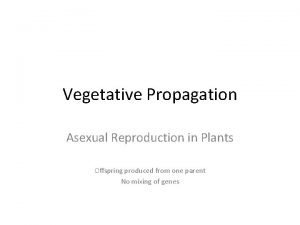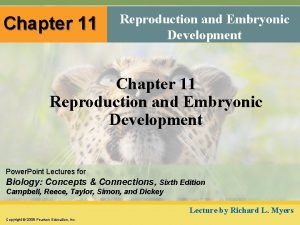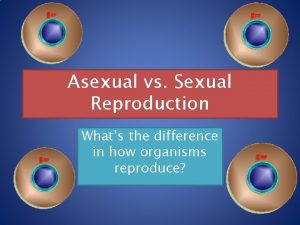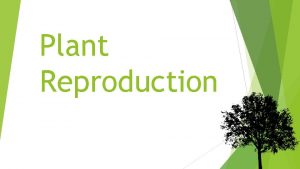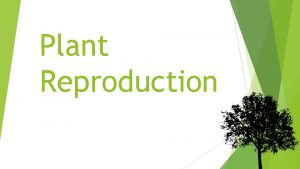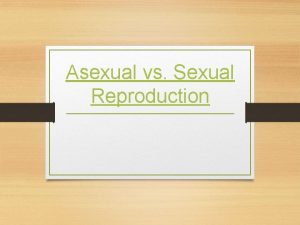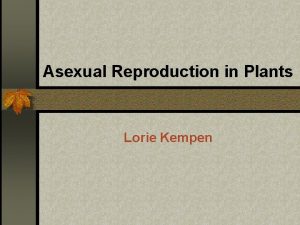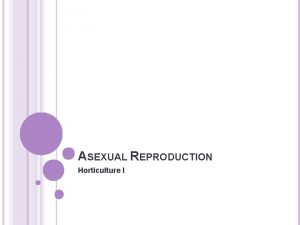Plant Reproduction Asexual Reproduction Some plants produce new














- Slides: 14

Plant Reproduction

Asexual Reproduction Some plants produce new plants with a leaf, stem, or another part instead of a seed. Asexual reproduction—only one parent organism or part of that organism produces a new organism The new organism is genetically identical to the parent.

Sexual Reproduction Involves both male and female sex cells that contribute genetic material to offspring. Fertilization occurs when sperm (male sex cell) and egg (female sex cell) join and combine their genetic material. Offspring have different genetic makeup than their parent organisms.

Plant Life Cycles All plants have 2 stages in their life cycle: Gametophyte stage Sporophyte stage

Gametophyte Stage Begins with a spore, or haploid cell. Through mitosis and cell division, the spore produces a plant structure or an entire plant called a gametophyte. The gametophyte produces male and female sex cells through meiosis.

Sporophyte Stage During sexual reproduction, a male sex cell and a female sex cell combine. If fertilization occurs, a diploid cell forms. The diploid cell is the beginning of the sporophyte stage. This cell divides through mitosis and cell division and forms the sporophyte.

Seedless Plants These are plants that do not produce seeds. Seedless plants can reproduce by asexual reproduction or by producing spores. The sporophyte produces the spores.

Seed Plants Most plants produce seeds that result from sexual reproduction. The plants produce pollen grains that contain sperm. Female structures in the plants produce one or more eggs.

Seed Plants The process that occurs when pollen grains land on a female plant structure of a plant in the same species is pollination. If a sperm from a pollen grain joins with an egg, this is fertilization. After fertilization, the diploid cell divides and forms an embryo, which is the beginning of the sporophyte stage.

Seed Plants The embryo and its food supply are enclosed within a protective coat. This is the seed. The seed will go through dormancy—a period of no growth, which will last until favorable environmental conditions emerge. The seed will begin to grow, which is called germination.

Gymnosperm Reproduction Pollen is produced by the male cone, and the female contains the egg. The female cone also contains the seed after fertilization.

Angiosperm Reproduction Most flowers have 4 main structures: petals, sepal, pistil, and stamen. The petals attract insects or animal pollinators The sepal is located under the petals and protect the flower when it is a bud Pistil—female reproductive organ of a flower Stamen—male reproductive organ of a flower

Angiosperm Reproduction The gametophyte stage lasts a short time, which includes the production of eggs and sperm by a flower. When a sperm fertilizes an egg, the diploid cell is the beginning of the sporophyte stage In flowering plants, the sporophyte stage lasts much longer than the gametophyte stage

Growth Cycles Annuals—plants that grow from seeds and produce flowers in one growing season (must be planted every year) Biennials—plants that require 2 growing seasons to produce flowers (may go through dormancy between growing seasons) Perennials—plants that grow and bud for many years (can go dormant for several months and regain their leaves in warmer temperatures)
 Asexual reproduction cell division
Asexual reproduction cell division Asexualk
Asexualk Asexual reproduction vs sexual reproduction venn diagram
Asexual reproduction vs sexual reproduction venn diagram Vegetative propagation
Vegetative propagation Fission vs budding
Fission vs budding Roundworms nervous system
Roundworms nervous system Budding asexual reproduction
Budding asexual reproduction Example asexual reproduction
Example asexual reproduction Layering asexual reproduction
Layering asexual reproduction Asexual
Asexual Asexual reproduction
Asexual reproduction Gastrula
Gastrula Is mitosis asexual
Is mitosis asexual Whats sexual reproduction
Whats sexual reproduction Example for sexual reproduction
Example for sexual reproduction



